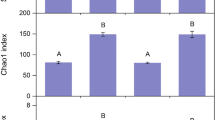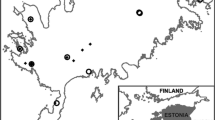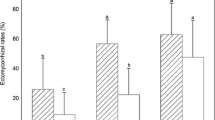Abstract
Bistorta vivipara is a widespread arctic-alpine ectomycorrhizal (ECM) plant species. Recent findings suggest that fungal communities associated with B. vivipara roots appear random over short distances, but at larger scales, environmental filtering structure fungal communities. Habitats in highly stressful environments where specialist species with narrower niches may have an advantage represent unique opportunity to test the effect of environmental filtering. We utilised high-throughput amplicon sequencing to identify ECM communities associated with B. vivipara in Svalbard. We compared ECM communities in a core habitat where B. vivipara is frequent (Dryas-heath) with edge habitats representing extremes in terms of nutrient availability where B. vivipara is less frequent (bird-manured meadow and a nutrient-depleted mine tilling). Our analysis revealed that soil conditions in edge habitats favour less diverse but more distinct ECM fungal communities with functional traits adapted to local conditions. ECM richness was overall lower in both edge habitats, and the taxonomic compositions of ECM fungi were in line with our functional expectations. Stress-tolerant genera such as Laccaria and Hebeloma were abundant in nutrient-poor mine site whereas functional competitors genera such as Lactarius and Russula were dominant in the nutrient-rich bird-cliff site. Our results suggest that ECM communities in rare edge habitats are most likely not subsets of the larger pool of ECM fungi found in natural tundra, and they may represent a significant contribution to the overall diversity of ECM fungi in the Arctic.



Similar content being viewed by others
References
Agerer R (2001) Exploration types of ectomycorrhizae. Mycorrhiza 11:107–114. doi:10.1007/s005720100108
Agerer R (2006) Fungal relationships and structural identity of their ectomycorrhizae. Mycol Prog 5:67–107. doi:10.1007/s11557-006-0505-x
Aronesty E (2013) Comparison of sequencing utility programs. Open Bioinform J 7:1–8
Avis PG (2012) Ectomycorrhizal iconoclasts: the ITS rDNA diversity and nitrophilic tendencies of fetid Russula. Mycologia 104:998–1007. doi:10.3852/11-399
Bahram M, Kohout P, Anslan S, Harend H, Abarenkov K, Tedersoo L (2015) Stochastic distribution of small soil eukaryotes resulting from high dispersal and drift in a local environment. ISME J doi:10.1038/ismej.2015.164
Bahram M, Kõljalg U, Courty P-E et al (2013) The distance decay of similarity in communities of ectomycorrhizal fungi in different ecosystems and scales. J Ecol 101:1335–1344. doi:10.1111/1365-2745.12120
Baxter JW, Dighton J (2001) Ectomycorrhizal diversity alters growth and nutrient acquisition of grey birch (Betula populifolia) seedlings in host–symbiont culture conditions. New Phytol 152:139–149. doi:10.1046/j.0028-646x.2001.00245.x
Berg MP, Verhoef HA (1998) Ecological characteristics of a nitrogen-saturated coniferous forest in The Netherlands. Biol Fertility Soils 26:258–267. doi:10.1007/s003740050377
Billings WD (1987) Constraints to plant growth, reproduction, and establishment in Arctic environments. Arct Alp Res 19:357–365. doi:10.2307/1551400
Bills JW, Roalson EH, Busch JW, Eidesen PB (2015) Environmental and genetic correlates of allocation to sexual reproduction in the circumpolar plant Bistorta vivipara. Am J Bot 102:1174–1186. doi:10.3732/ajb.1400431
Blaalid R, Carlsen T, Kumar S, Halvorsen R, Ugland KI, Fontana G, Kauserud H (2012) Changes in the root-associated fungal communities along a primary succession gradient analysed by 454 pyrosequencing. Mol Ecol 21:1897–1908. doi:10.1111/j.1365-294X.2011.05214.x
Blaalid R, Davey ML, Kauserud H, Carlsen T, Halvorsen R, Høiland K, Eidesen PB (2014) Arctic root-associated fungal community composition reflects environmental filtering. Mol Ecol 23:649–659. doi:10.1111/mec.12622
Blanchet FG, Legendre P, Borcard D (2008) Forward selection of explanatory variables. Ecology 89:2623–2632
Bogar LM, Kennedy PG (2013) New wrinkles in an old paradigm: neighborhood effects can modify the structure and specificity of Alnus-associated ectomycorrhizal fungal communities. FEMS Microbiol Ecol 83:767–777. doi:10.1111/1574-6941.12032
Botnen S, Vik U, Carlsen T, Eidesen PB, Davey ML, Kauserud H (2014) Low host specificity of root associated fungi at an Arctic site. Mol Ecol 23:975–985. doi:10.1111/mec.12646
Branco S (2010) Serpentine soils promote ectomycorrhizal fungal diversity. Mol Ecol 19:5566–5576. doi:10.1111/j.1365-294X.2010.04913.x
Branco S, Ree RH (2010) Serpentine soils do not limit mycorrhizal fungal diversity. PLoS One 5:e11757. doi:10.1371/journal.pone.0011757
Davey M, Blaalid R, Vik U, Carlsen T, Kauserud H, Eidesen PB (2015) Primary succession of Bistorta vivipara (L.) Delabre (Polygonaceae) root-associated fungi mirrors plant succession in two glacial chronosequences. Environ Microbiol 17:2777–2790. doi:10.1111/1462-2920.12770
Dickie I, Martínez-García L, Koele N, Grelet GA, Tylianakis J, Peltzer D, Richardson S (2013) Mycorrhizas and mycorrhizal fungal communities throughout ecosystem development. Plant and Soil 367:11–39. doi:10.1007/s11104-013-1609-0
Druebert C, Lang C, Valtanen K, Polle A (2009) Beech carbon productivity as driver of ectomycorrhizal abundance and diversity. Plant Cell Environ 32:992–1003. doi:10.1111/j.1365-3040.2009.01983.x
Edgar RC (2010) Search and clustering orders of magnitude faster than BLAST. Bioinformatics 26:2460–2461. doi:10.1093/bioinformatics/btq461
Eidesen PB, Müller E, Lettner C et al. (2013) Tetraploids do not form cushions: association of ploidy level, growth form and ecology in the High Arctic Saxifraga oppositifolia L. s. lat. (Saxifragaceae) in Svalbard. Polar Res 32
Elberling B, Søndergaard J, Jensen LA et al (2007) Arctic vegetation damage by winter-generated coal mining pollution released upon thawing. Environ Sci Technol 41:2407–2413. doi:10.1021/es061457x
Fujimura KE, Egger KN (2012) Host plant and environment influence community assembly of High Arctic root-associated fungal communities. Fungal Ecology 5:409–418 doi:http://dx.doi.org/10.1016/j.funeco.2011.12.010
Gardes M, Dahlberg A (1996) Mycorrhizal diversity in arctic and alpine tundra: an open question. New Phytol 133:147–157. doi:10.1111/j.1469-8137.1996.tb04350.x
Geml J, Timling I, Robinson CH et al (2012) An arctic community of symbiotic fungi assembled by long-distance dispersers: phylogenetic diversity of ectomycorrhizal basidiomycetes in Svalbard based on soil and sporocarp DNA. J Biogeogr 39:74–88. doi:10.1111/j.1365-2699.2011.02588.x
Ihrmark K, Bödeker ITM, Cruz-Martinez K et al (2012) New primers to amplify the fungal ITS2 region—evaluation by 454-sequencing of artificial and natural communities. FEMS Microbiol Ecol 82:666–677. doi:10.1111/j.1574-6941.2012.01437.x
Ishida TA, Nara K, Tanaka M, Kinoshita A, Hogetsu T (2008) Germination and infectivity of ectomycorrhizal fungal spores in relation to their ecological traits during primary succession. New Phytol 180:491–500. doi:10.1111/j.1469-8137.2008.02572.x
Jonsson LM, Nilsson M-C, Wardle DA, Zackrisson O (2001) Context dependent effects of ectomycorrhizal species richness on tree seedling productivity. Oikos 93:353–364. doi:10.1034/j.1600-0706.2001.930301.x
Kauserud H, Kumar S, Brysting A, Nordén J, Carlsen T (2012) High consistency between replicate 454 pyrosequencing analyses of ectomycorrhizal plant root samples. Mycorrhiza 22:309–315. doi:10.1007/s00572-011-0403-1
Koide RT, Fernandez C, Petprakob K (2011) General principles in the community ecology of ectomycorrhizal fungi. Ann Forest Sci 68:45–55. doi:10.1007/s13595-010-0006-6
Kõljalg U, Nilsson RH, Abarenkov K et al (2013) Towards a unified paradigm for sequence-based identification of fungi. Mol Ecol 22:5271–5277. doi:10.1111/mec.12481
Korhonen A, Lehto T, Repo T (2013) Frost hardiness of mycorrhizal (Hebeloma sp.) and non-mycorrhizal Scots pine roots. Mycorrhiza 23:551–559. doi:10.1007/s00572-013-0497-8
Legendre P, Gallagher ED (2001) Ecologically meaningful transformations for ordination of species data. Oecologia 129:271–280. doi:10.1007/s004420100716
Leprince F, Quiquampoix H (1996) Extracellular enzyme activity in soil: effect of pH and ionic strength on the interaction with montmorillonite of two acid phosphatases secreted by the ectomycorrhizal fungus Hebeloma cylindrosporum. Eur J Soil Sci 47:511–522. doi:10.1111/j.1365-2389.1996.tb01851.x
Mayfield MM, Levine JM (2010) Opposing effects of competitive exclusion on the phylogenetic structure of communities. Ecol Lett 13:1085–1093. doi:10.1111/j.1461-0248.2010.01509.x
Molina R, Massicotte H, Trappe JM (1992) Specificity phenomena in mycorrhizal symbioses: community-ecological consequences and practical implications. In: Allen M (ed) Mycorrhizal functioning: an integrative plant-fungal process. Springer, New York, pp 357–423
Mundra S, Bahram M, Tedersoo L, Kauserud H, Halvorsen R, Eidesen PB (2015a) Temporal variation of Bistorta vivipara-associated ectomycorrhizal fungal communities in the High Arctic. Mol Ecol 24:6289–6302. doi:10.1111/mec.13458
Mundra S, Halvorsen R, Kauserud H, Müller E, Vik U, Eidesen PB (2015b) Arctic fungal communities associated with roots of Bistorta vivipara do not respond to the same fine-scale edaphic gradients as the aboveground vegetation. New Phytol 205:1587–1597
Murray MG, Thompson WF (1980) Rapid isolation of high molecular weight plant DNA. Nucleic Acids Res 8:4321–4326. doi:10.1093/nar/8.19.4321
Nguyen NH, Smith D, Peay K, Kennedy P (2014) Parsing ecological signal from noise in next generation amplicon sequencing. New Phytol 205:1389–1393. doi:10.1111/nph.12923
Nilsson RH, Veldre V, Hartmann M et al (2010) An open source software package for automated extraction of ITS1 and ITS2 from fungal ITS sequences for use in high-throughput community assays and molecular ecology. Fungal Ecol 3:284–287, http://dx.doi.org/10.1016/j.funeco.2010.05.002
Oksanen J, Blanchet FG, Kindt R et al. (2013) Vegan: community ecology package. R package version 2.0-7. http://CRAN.R-project.org/package=vegan.
Peay KG, Bruns TD (2014) Spore dispersal of basidiomycete fungi at the landscape scale is driven by stochastic and deterministic processes and generates variability in plant–fungal interactions. New Phytol 204:180–191. doi:10.1111/nph.12906
Peay KG, Schubert MG, Nguyen NH, Bruns TD (2012) Measuring ectomycorrhizal fungal dispersal: macroecological patterns driven by microscopic propagules. Mol Ecol 21:4122–4136. doi:10.1111/j.1365-294X.2012.05666.x
Pena R, Offermann C, Simon J et al (2010) Girdling affects ectomycorrhizal fungal (EMF) diversity and reveals functional differences in EMF community composition in a beech forest. Appl Environ Microbiol 76:1831–1841. doi:10.1128/aem.01703-09
Core Development Team R (2014) R: A language and environment for statistical computing. R Foundation for Statistical Computing, Vienna, http://www.R-project.org
Ramesh G, Podila GK, Gay G, Marmeisse R, Reddy MS (2009) Different patterns of regulation for the copper and cadmium metallothioneins of the ectomycorrhizal fungus Hebeloma cylindrosporum. Appl Environ Microbiol 75:2266–2274. doi:10.1128/aem.02142-08
Reddy MS, Prasanna L, Marmeisse R, Fraissinet-Tachet L (2014) Differential expression of metallothioneins in response to heavy metals and their involvement in metal tolerance in the symbiotic basidiomycete Laccaria bicolor. Microbiology 160:2235–2242. doi:10.1099/mic.0.080218-0
Roberts DW (2014) Package “labdsv”.
Søndergaard J, Elberling B, Asmund G (2008) Metal speciation and bioavailability in acid mine drainage from a high Arctic coal mine waste rock pile: Temporal variations assessed through high-resolution water sampling, geochemical modelling and DGT. Cold Regions Sci Technol 54:89–96, http://dx.doi.org/10.1016/j.coldregions.2008.01.003
Taylor DL, Bruns TD (1999) Community structure of ectomycorrhizal fungi in a Pinus muricata forest: minimal overlap between the mature forest and resistant propagule communities. Mol Ecol 8:1837–1850. doi:10.1046/j.1365-294x.1999.00773.x
Tedersoo L, Bahram M, Põlme S et al. (2014) Global diversity and geography of soil fungi. Science 346
Tedersoo L, Smith ME (2013) Lineages of ectomycorrhizal fungi revisited: Foraging strategies and novel lineages revealed by sequences from belowground. Fungal Biol Rev 27:83–99, http://dx.doi.org/10.1016/j.fbr.2013.09.001
Timling I, Dahlberg A, Walker DA, Gardes M, Charcosset JY, Welker JM, Taylor DL (2012) Distribution and drivers of ectomycorrhizal fungal communities across the north american arctic. Ecosphere 3:1–25. doi:10.1890/ES12-00217.1
Timling I, Taylor DL (2012) Peeking through a frosty window: molecular insights into the ecology of Arctic soil fungi. Fungal Ecol 5:419–429, http://dx.doi.org/10.1016/j.funeco.2012.01.009
Totland Ø, Nyléhn J (1998) Assessment of the effects of environmental change on the performance and density of Bistorta vivipara: the use of multivariate analysis and experimental manipulation. J Ecol 86:989–998. doi:10.1046/j.1365-2745.1998.00318.x
Troug E (1947) Soil reaction influence on availability of plant nutrients. Soil Sci Soc Am Proc 11:305–308
Ugland KI, Gray JS, Ellingsen KE (2003) The species–accumulation curve and estimation of species richness. J Anim Ecol 72:888–897. doi:10.1046/j.1365-2656.2003.00748.x
Washburn AL (1980) Geocryology: a survey of periglacial processes and environments. Wiley, Cambridge
White TJ, Bruns T, Lee S, Taylor J, Innis M, Gelfand D, Shinsky J, White T (1990) Amplification and direct sequencing of fungal ribosomal RNA genes for phylogenetics, PCR Protocols: A Guide to Methods and Applications. Academic Press, London, pp 315–322
Wilkinson A, Solan M, Alexander I, Johnson D (2012) Species richness and nitrogen supply regulate the productivity and respiration of ectomycorrhizal fungi in pure culture. Fungal Ecol 5:211–222, http://dx.doi.org/10.1016/j.funeco.2011.08.007
Wookey PA, Welker JM, Parsons AN, Press MC, Callaghan TV, Lee JA (1994) Differential Growth, Allocation and Photosynthetic Responses of Polygonum viviparum to Simulated Environmental Change at a High Arctic Polar Semi-Desert. Oikos 70:131–139. doi:10.2307/3545708
Yao F, Vik U, Brysting AK, Carlsen T, Halvorsen R, Kauserud H (2013) Substantial compositional turnover of fungal communities in an alpine ridge-to-snowbed gradient. Mol Ecol 22:5040–5052. doi:10.1111/mec.12437
Young KL, Woo M-k, Edlund SA (1997) Influence of Local Topography, Soils, and Vegetation on Microclimate and Hydrology at a High Arctic Site, Ellesmere Island, Canada. Arct Alp Res 29:270–284. doi:10.2307/1552141
Zmudczyńska K, Olejniczak I, Zwolicki A, Iliszko L, Convey P, Stempniewicz L (2012) Influence of allochtonous nutrients delivered by colonial seabirds on soil collembolan communities on Spitsbergen. Polar Biol 35:1233–1245. doi:10.1007/s00300-012-1169-4
Acknowledgements
We thank Anna Vader for help in sampling. We acknowledge the editor and two anonymous reviewers for their helpful comments and suggestions, which helped us to improve the manuscript. This research was funded by ConocoPhillips and Lundin Petroleum through The Northern Area.
Author information
Authors and Affiliations
Corresponding author
Ethics declarations
Conflict of interest
The authors declare that they have no conflict of interest.
Electronic supplementary material
Below is the link to the electronic supplementary material.
ESM 1
DOCX 26517 kb
Rights and permissions
About this article
Cite this article
Mundra, S., Bahram, M. & Eidesen, P.B. Alpine bistort (Bistorta vivipara) in edge habitat associates with fewer but distinct ectomycorrhizal fungal species: a comparative study of three contrasting soil environments in Svalbard. Mycorrhiza 26, 809–818 (2016). https://doi.org/10.1007/s00572-016-0716-1
Received:
Accepted:
Published:
Issue Date:
DOI: https://doi.org/10.1007/s00572-016-0716-1




